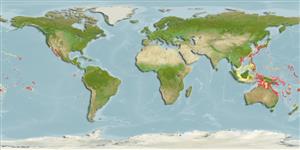>
Acanthuriformes (Surgeonfishes) >
Chaetodontidae (Butterflyfishes)
Etymology: Chaetodon: Greek, chaite = hair + Greek, odous = teeth (Ref. 45335).
Eponymy: Dr Albert Karl Ludwig Gotthilf Günther (1830–1914) was a German-born British zoologist, ichthyologist and herpetologist. [...] (Ref. 128868), visit book page.
More on author: Ahl.
Environment: milieu / climate zone / rango de profundidad / distribution range
Ecología
marino asociado a arrecife; rango de profundidad 5 - 40 m (Ref. 9710). Tropical
Western Pacific: anti-equatorial, from southern Japan to Taiwan and the Ryukyu Islands and from Papua New Guinea and the Great Barrier Reef to Lord Howe Island and New South Wales (Ref. 9710). Recently reported from Tonga (Ref. 53797).
Tamaño / Peso / Age
Madurez: Lm ? range ? - ? cm
Max length : 18.0 cm TL macho / no sexado; (Ref. 9710)
Espinas dorsales (total) : 13; Radios blandos dorsales (total) : 21 - 22; Espinas anales: 3; Radios blandos anales: 18.
Body shape (shape guide): short and / or deep; Cross section: compressed.
Inhabit seaward reefs in areas with rich coral growth. Usually solitary, but also a schooling species that is often on the move, usually in areas prone to strong currents. Usually deep in Indonesia and adults are rarely found in less than 40 m depth. Mainly found in sponge zones and deep water occurrence is habitat related, not cold water as sometimes suggested. This species will travel in open water and cleans large pelagic fishes (Ref. 48636). Oviparous (Ref. 205). Form pairs during breeding (Ref. 205).
Life cycle and mating behavior
Madurez | Reproducción | Puesta | Huevos | Fecundidad | Larva
Distinct pairing (Ref. 205).
Steene, R.C., 1978. Butterfly and angelfishes of the world. A.H. & A.W. Reed Pty Ltd., Australia. vol. 1. 144 p. (Ref. 4859)
IUCN Red List Status (Ref. 130435: Version 2025-1)
Threat to humans
Harmless
Human uses
Pesquerías: comercial; Acuario: Comercial
Herramientas
Special reports
Download XML
Fuentes de Internet
Estimates based on models
Preferred temperature (Referencia
123201): 19.9 - 28.9, mean 27.4 °C (based on 356 cells).
Phylogenetic diversity index (Referencia
82804): PD
50 = 0.5000 [Uniqueness, from 0.5 = low to 2.0 = high].
Bayesian length-weight: a=0.02291 (0.01133 - 0.04632), b=3.00 (2.83 - 3.17), in cm total length, based on LWR estimates for this Genus-body shape (Ref.
93245).
Nivel trófico (Referencia
69278): 2.8 ±0.26 se; based on food items.
Resiliencia (Referencia
120179): Alto, población duplicada en un tiempo mínimo inferior a 15 meses (Preliminary K or Fecundity.).
Fishing Vulnerability (Ref.
59153): Low vulnerability (10 of 100).
🛈
Nutrients (Ref.
124155): Calcium = 99.7 [51.9, 151.0] mg/100g; Iron = 0.823 [0.495, 1.335] mg/100g; Protein = 18.5 [17.3, 19.6] %; Omega3 = 0.113 [0.071, 0.177] g/100g; Selenium = 34.9 [19.8, 64.6] μg/100g; VitaminA = 44.8 [12.5, 156.3] μg/100g; Zinc = 1.52 [1.04, 2.16] mg/100g (wet weight);
